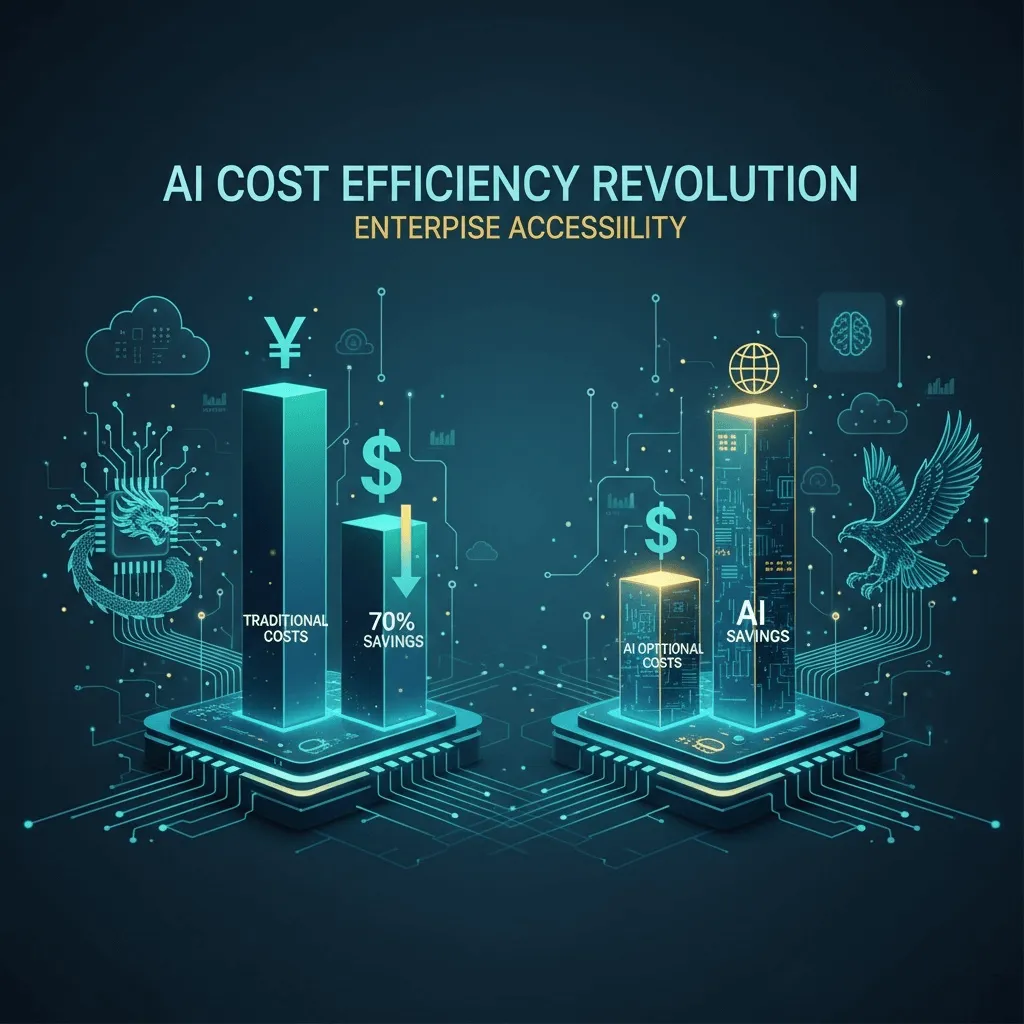DeepSeek: The $294k AI Breaking Silicon Valley


The Day AI Economics Changed Forever
On a quiet Tuesday in September 2025, a research team in Hangzhou, China, published findings that sent shockwaves through Silicon Valley boardrooms and enterprise AI departments worldwide. DeepSeek, a relatively unknown AI startup, revealed they had trained their frontier-level DeepSeek-R1 model for just $294,000—less than the cost of a luxury sports car.
To put this in perspective: OpenAI reportedly spends $22 million every single day on operations. That’s enough to train 75 DeepSeek R1-level models daily. Meanwhile, most enterprise AI initiatives have been shelved because organizations assume that competitive AI requires the kind of capital expenditure typically reserved for major infrastructure projects.
DeepSeek just proved them wrong. And in doing so, they’ve fundamentally altered the economics of enterprise AI adoption.
This isn’t just a cost optimization story. It’s a paradigm shift that transforms AI from an exclusive playground for tech giants into an accessible tool for mid-market companies, startups, and organizations that previously couldn’t afford to compete in the AI arms race.
The Great AI Cost Deception
For years, the AI industry has operated under a fundamental assumption: better AI requires exponentially more resources. Want GPT-4 level performance? You’ll need thousands of high-end GPUs, months of training time, and budgets that rival small country GDPs. This narrative has been so pervasive that entire business strategies have been built around it.
Large enterprises budgeted millions for AI initiatives, assuming that competitive performance required massive capital investment. Mid-market companies simply opted out, convinced that meaningful AI capabilities were beyond their financial reach. Venture capitalists funneled billions into AI companies based partly on the assumption that massive computational requirements created natural barriers to entry.
DeepSeek’s breakthrough shatters this entire economic model. Their R1 model, trained on A100 GPUs in just 80 hours, achieves performance levels that compete directly with models that cost thousands of times more to develop. The implications are staggering: if frontier AI performance can be achieved for the cost of a mid-tier enterprise software license, then every organization’s AI strategy needs immediate reevaluation.
The Technical Revolution Behind the Economics
DeepSeek’s achievement isn’t just about spending less money—it’s about fundamentally more efficient approaches to AI development. Their breakthrough centers on several key innovations:
Efficient Architecture Design: Instead of simply scaling up existing architectures, DeepSeek optimized their model design for computational efficiency. They achieved frontier performance with fewer parameters through smarter architectural choices rather than brute force scaling.
Training Optimization: The team developed novel training techniques that achieve convergence faster and with less computational overhead. Their 80-hour training run on A100 GPUs demonstrates that efficiency gains at the algorithmic level can dramatically reduce resource requirements.
Hardware Utilization: By optimizing for specific hardware configurations and maximizing GPU utilization, DeepSeek extracted more performance per dollar spent than traditional approaches that often leave significant computational capacity unused.
Open Source Philosophy: Unlike proprietary models that require massive ongoing operational costs, DeepSeek’s approach emphasizes efficient, open methodologies that can be reproduced and improved by the broader community.
Enterprise Implications: The Great Leveling
For enterprise decision-makers, DeepSeek’s breakthrough represents more than cost savings—it’s a competitive reset that changes who can play in the AI game.
Democratized AI Development: Mid-market companies can now consider developing custom AI models for specific business applications. A $300,000 AI development project is within reach for organizations that would never consider a $30 million initiative.
Reduced Vendor Dependence: Instead of relying entirely on expensive API calls to major AI providers, enterprises can explore developing specialized models for their specific use cases. This reduces ongoing operational costs and increases control over AI capabilities.
Faster Innovation Cycles: Lower development costs enable more experimentation. Organizations can afford to test multiple AI approaches for different business problems, leading to more innovative applications and faster optimization.
Geographic Expansion: Companies in markets outside the traditional AI epicenters—Silicon Valley, London, Tel Aviv—suddenly have access to frontier AI capabilities without requiring proximity to massive computational infrastructure.
The Competitive Landscape Shift
DeepSeek’s breakthrough forces a fundamental recalculation of competitive dynamics in the AI industry:
Tech Giants’ Moats Erode: If small teams can achieve frontier performance for reasonable costs, then the massive computational advantages held by Google, Microsoft, and OpenAI become less decisive. Competition shifts from who can spend the most to who can innovate most efficiently.
New Market Entrants: Expect a wave of AI startups and enterprise initiatives that previously couldn’t compete on computational resources. The barrier to entry just dropped from hundreds of millions to hundreds of thousands.
Investment Strategy Changes: Venture capital will likely shift from funding massive computational builds to supporting efficient innovation. The premium for AI companies will come from algorithmic breakthroughs rather than resource accumulation.
Global AI Distribution: Countries and regions that couldn’t compete in the resource-intensive AI race now have viable paths to AI sovereignty and competitive positioning.
Implementation Strategy for Enterprises
Organizations looking to capitalize on this new efficiency paradigm should consider several strategic approaches:
Reassess AI Budgets: Current AI initiatives budgeted at millions may be achievable for hundreds of thousands. This allows for either significant cost savings or expansion of AI applications across more business areas.
Custom Model Development: Instead of relying entirely on general-purpose models from major providers, consider developing specialized models for specific business applications where the training data and use cases are well-defined.
Hybrid Approaches: Combine cost-efficient custom models for specialized tasks with API access to larger models for general-purpose applications. This optimization can dramatically reduce ongoing operational costs.
Competitive Timing: Organizations that move quickly to implement efficient AI approaches will have temporary advantages while competitors continue operating under the old cost assumptions.
The Broader Economic Impact
DeepSeek’s breakthrough has implications that extend far beyond individual enterprise strategies:
Market Disruption: Public markets have already responded dramatically, with tech and energy stocks experiencing significant volatility as investors recalibrate the value propositions of resource-intensive AI companies.
Supply Chain Shifts: If AI development requires significantly fewer high-end GPUs, the entire semiconductor supply chain—from NVIDIA to TSMC—faces changed demand patterns and pricing pressures.
Innovation Acceleration: Lower barriers to AI development will likely accelerate innovation across industries as more organizations can afford to experiment with AI applications.
Global Competition: Countries that couldn’t compete in the resource-intensive AI race now have viable paths to AI competitiveness, potentially reshaping global technology leadership.
The Future of Efficient AI
DeepSeek’s achievement represents more than a single breakthrough—it’s the beginning of a new era in AI development where efficiency trumps raw computational power. This shift has profound implications for how enterprises approach AI strategy, investment, and competitive positioning.
The organizations that recognize this paradigm shift early and adjust their AI strategies accordingly will find themselves with significant advantages over competitors still operating under the old economic assumptions. Meanwhile, those that continue assuming AI requires massive capital investment may find themselves outmaneuvered by more efficient competitors.
The AI revolution isn’t just about what artificial intelligence can do—it’s about who can afford to participate. DeepSeek just lowered the admission price from hundreds of millions to hundreds of thousands, and that changes everything.
The question isn’t whether this efficiency revolution will reshape enterprise AI adoption. The question is whether your organization will be positioned to take advantage of it, or whether you’ll be left defending budget assumptions that no longer reflect reality.
Frequently Asked Questions
How does DeepSeek’s $294,000 training cost compare to other AI models?
DeepSeek-R1’s $294,000 training cost represents a dramatic departure from industry norms. For comparison, OpenAI spends approximately $22 million daily on operations—enough to train 75 DeepSeek R1-equivalent models every day. Large language models like GPT-4 reportedly cost tens of millions to train, while DeepSeek achieved competitive frontier performance for less than the cost of a luxury car. This 100x+ cost reduction fundamentally changes the economics of AI development and makes frontier AI accessible to mid-market enterprises.
What technical innovations enabled DeepSeek to achieve such dramatic cost reductions?
DeepSeek’s breakthrough combines several key innovations: optimized model architecture that achieves frontier performance with fewer parameters, novel training techniques that reach convergence faster, maximized hardware utilization on A100 GPUs, and an 80-hour training run that demonstrates algorithmic efficiency over brute force scaling. Their approach emphasizes smart engineering over massive resource expenditure, proving that efficiency gains at the algorithmic level can dramatically reduce computational requirements while maintaining performance quality.
What does this mean for enterprise AI strategy and budgeting?
This breakthrough fundamentally changes enterprise AI economics. Organizations previously budgeting millions for AI initiatives may achieve similar results for hundreds of thousands. This enables mid-market companies to consider custom AI model development, reduces dependence on expensive API services from major providers, allows for more experimentation across business applications, and shifts competitive advantage from capital resources to algorithmic innovation. Enterprises should reassess current AI budgets and consider developing specialized models for specific business use cases.
How will this impact the competitive landscape among AI companies?
DeepSeek’s efficiency breakthrough erodes the computational moats that tech giants have relied upon, lowering barriers to entry from hundreds of millions to hundreds of thousands, enabling new market entrants who couldn’t previously compete on resources, shifting venture capital focus from massive computational builds to efficient innovation, and potentially reshaping global AI competition by making frontier AI accessible to more countries and regions. The competitive advantage moves from who can spend the most to who can innovate most efficiently.
What are the broader market implications of this cost efficiency breakthrough?
The breakthrough has already triggered significant market volatility, with tech and energy stocks experiencing major movements as investors recalibrate AI company valuations. Supply chain impacts include potential reduced demand for high-end GPUs, changed semiconductor industry dynamics, and pricing pressure throughout the AI infrastructure stack. Innovation acceleration is expected as more organizations can afford AI experimentation, while global competition may shift as countries develop viable paths to AI competitiveness without massive resource requirements. This represents a fundamental restructuring of AI industry economics.